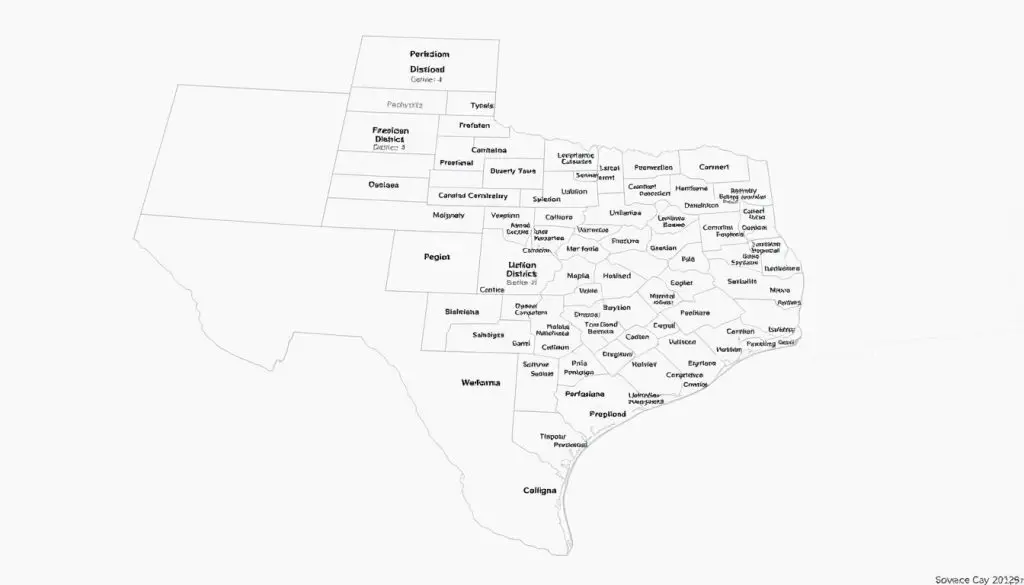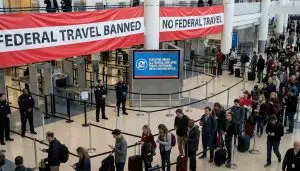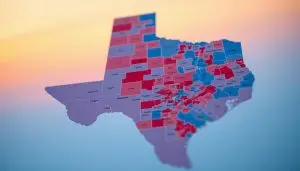Federal Court Blocks New Texas House Map for Midterms
A federal court issues an injunction against the new Texas House Map, affecting midterm elections and district representation.

A federal court has stopped the new Texas political map from being used before the midterm elections. A 2-1 decision from a panel in El Paso found the map harmed Black and Hispanic voters. The judges said the map was drawn unfairly.
Under the order, Texas must go back to its 2021 map for the elections. Gov. Greg Abbott plans to appeal to the U.S. Supreme Court. He says the changes were not about race but about politics.
This fight is part of a bigger battle over control of Congress. Missouri and North Carolina have maps that help Republicans. But California’s move could help Democrats. For more on the ruling, see this federal court decision coverage.
The court’s decision means the plaintiffs might win at trial. This is a big moment before voting starts. The elections will use the old map unless the Supreme Court changes it, as reported by the 2-1 ruling overview.
Texas House Map Key Takeaways
- A federal court injunction blocks Texas from using its newly redrawn congressional map.
- The 2-1 panel found substantial evidence of racial gerrymandering affecting Black and Hispanic voters.
- Texas must use the 2021 districts for the midterm elections unless the Supreme Court steps in.
- The halted plan would have added five GOP-leaning seats, intensifying the redistricting battle.
- Gov. Greg Abbott plans a swift appeal, keeping legal and political timelines tight.
- National shifts in Missouri, North Carolina, and California raise the stakes for control of the House.
What the Federal Ruling Means for the 2026 Midterms and Redistricting Battles
The 2026 midterms are now at a crossroads due to a court order. This order pauses Texas’s new congressional lines. It also changes the map fight across the country. Voters, campaigns, and advocacy groups are adjusting their plans based on the Texas legislative map and the Texas House representatives map.
Key decision: 2-1 panel in El Paso blocks the use of the redrawn congressional map
A 2-1 decision from a three-judge panel in El Paso has stopped Texas from using its new congressional map. This means the map won’t be used for the 2026 midterms. The panel believes the case needs a full trial before any new lines are used—more Top Stories in the news.
Judge Jeffrey V. Brown’s opinion and the finding of racial gerrymandering
Judge Jeffrey V. Brown wrote that there’s a good chance the plaintiffs will win their case. He said the map’s design was influenced by race. This opinion puts the Texas legislative map and the Texas House representatives map at the heart of the case.
Immediate impact: Reverting to the 2021 Texas legislative map for upcoming elections
The order means Texas will use its 2021 map for upcoming elections. Campaigns must adjust their plans and fundraising. This includes changing voter outreach in shifting suburbs.
As explained in this federal court ruling, candidates will run under the older map unless a higher court intervenes.
National context: Missouri and North Carolina add GOP seats; California’s counter-move
Missouri and North Carolina have added a Republican seat each. California has approved a plan that could help Democrats. These changes make the 2026 midterms more essential and show how one state’s fight can affect the national balance.
The court’s injunction keeps voters from casting ballots under lines that may not comply with the Constitution while the case proceeds.
Bottom line for now: candidates, donors, and organizers must adapt to the 2021 Texas legislative map. They need to track appeals and plan for changes that could affect the Texas House representatives’ map heading into the 2026 midterms.
Texas House Map: Allegations of Racial Gerrymandering and Partisan Motives
The court examined the Texas House district map closely. They focused on how race was used in drawing district lines. Judges compared the summer changes to the Voting Rights Act and constitutional rules.
The evidence showed a plan to change urban and suburban areas. These areas had strong coalitions of minority voters.
How the summer redraw targeted Black and Hispanic voters, according to the court
Testimony and data showed that the map split voting precincts. These precincts had Black and Hispanic voters voting together. The court said this reduced support for minority candidates.
Plaintiffs argued that the changes were made to control the map. They said the plan used race as a tool, not just a result of neighborhood sorting.
Partisan versus racial gerrymandering: GOP defense and the 2019 Supreme Court precedent
Republican leaders said the map was about party politics, not race. They pointed to vote history and presidential margins to support their claim. But the court looked at whether race was the main reason for the changes.
This distinction is essential under the Voting Rights Act. If race were the main reason, mapmakers had to meet a higher standard. This is true even if party goals were also involved.
Coalition districts at issue: Dallas and Houston areas, where minority voters collectively hold power
Four coalition districts were in the spotlight. These districts were near Dallas and Houston. In these areas, Black and Hispanic voters could choose their representatives.
Under the new map, these coalitions were broken up. Shared precincts were split, diluting turnout. Opponents said this made it harder for minority voters to have a say.
Data shifts: From 16 to 14 majority-minority districts; elimination of five coalition districts
The number of majority-minority districts dropped from 16 to 14. Five coalition districts were lost. Analysts noted that five paired Democratic incumbents were Black or Hispanic.
Map architects said they added an eighth Hispanic-majority district and two new Black-majority districts. Critics said these seats were fragile in general elections. They pointed to higher white turnout and recent presidential margins.
An AP review showed 30 districts would lean toward Trump by 10 points or more. This highlights the partisan impact on the Texas House district map.
The debate centers on whether the map reflects racial gerrymandering or a legal partisan strategy. It also questions if the map complies with the Voting Rights Act.
Inside the Legal Clash: DOJ Letter, 5th Circuit Guidance, and the Path to the Supreme Court
The battle over Texas’s legislative map heated up after a summer full of drama. The DOJ Civil Rights Division and the 5th Circuit played significant roles in this. They argued about coalition districts under the Voting Rights Act. This debate now affects the Texas House district map and could lead to a Supreme Court appeal.
Key filings and court language set the stage for what’s next. Lawmakers had to consider federal advice, district data, and election schedules. Judges closely examined the lawmakers’ motives and methods. As the case moves forward, both sides are watching how legal standards influence mapmaking.

DOJ Civil Rights Division’s July letter and its influence on Texas Legislature mapmaking
In July, the DOJ Civil Rights Division told Texas to change four districts. They said these districts didn’t follow the Voting Rights Act. This advice came as the Texas Legislature was updating its map, and it quickly became part of the debate.
Lawmakers focused on districts in Dallas and Houston, where coalition voting is key. The DOJ’s advice influenced the choices made in these districts. The Texas Tribune reported on how the fight escalated, as seen in this redistricting ruling overview.
The 5th Circuit’s stance on aggregating minority groups under the Voting Rights Act
The 5th Circuit ruled that minority groups can’t be combined to prove vote dilution. They said each group must be judged on its own under the Voting Rights Act. This ruling made it harder to create coalition districts during redistricting.
The court looked at this precedent when reviewing the map. They saw how the 5th Circuit’s rule affected the Texas House district map’s treatment of shared power.
Why the panel called the DOJ-based rationale “legally incorrect” but influential
The panel found the DOJ’s rationale to be wrong, but it still influenced the mapmaking process. This mix of influence and accuracy was key in the court’s review of intent and district lines.
Legislative statements and timing were important. The judges followed the evolution of the Texas Legislature’s map. They also looked at how the DOJ’s letter affected these choices, focusing on coalition seats.
What’s next: Abbott’s appeal strategy, possible timelines, and implications for the Texas House district map
Gov. Greg Abbott plans to appeal to the Supreme Court quickly. The timeline is now critical. Briefs, possible stays, and argument windows will decide which map is used next.
The outcome will influence how the Voting Rights Act applies to coalition districts. It will also show how the 5th Circuit’s approach fits into national law. And it will highlight the importance of executive-branch signals. Each step will shape the Texas House district map for 2026.
Texas House Map Conclusion
The Texas House Map ruling has stopped a key plan to grow GOP gains before the 2026 midterms. For now, elections will go back to the 2021 lines. Judge Jeffrey V. Brown and an Obama appointee found the summer redraw likely crossed racial discrimination lines.
The panel pointed out dismantled coalition districts in Dallas and Houston. They also noted fewer majority-minority seats and pairings that hurt Black and Hispanic incumbents. Right now, Texas House districts are in flux, and the Texas government map is a big issue in midterm redistricting.
The stakes are high, not just in Austin. Missouri and North Carolina are adding Republican seats, while California voters approved a plan to help Democrats. Texas leaders plan to appeal to the Supreme Court to revive a map that adds five GOP seats.
Until then, the ruling suggests courts might protect coalition voting rights under the Voting Rights Act. This could change how Texas House districts are drawn and how they are tested.
Voters and campaigns now face a tight schedule and legal uncertainty. If higher courts back the panel, the 2021 lines will likely govern the next election cycle. If the state wins, the newer Texas representatives map could return, changing House math in Washington.
For a quick update on the judges’ decision and its effects, see this Texas House Map ruling update. Either way, the outcome will shape the Texas government map and set a model for midterm redistricting battles across the country.
Texas House Map FAQ
What did the federal court decide about the newly redrawn Texas U.S. House map?
A three-judge panel in El Paso blocked Texas from using its new congressional map. They found it likely racially gerrymandered, not just a partisan move. An injunction was issued while the case continues.
Who authored the decision, and what did the opinion say about racial gerrymandering?
U.S. District Judge Jeffrey V. Brown wrote the majority opinion. He said there’s strong evidence that Texas racially gerrymandered the 2025 map. This is different from typical partisan mapmaking.
What is the immediate impact on the 2026 midterms and the Texas House district map?
Unless higher courts intervene, Texas must use the 2021 map for elections. This affects campaign plans and the expected partisan balance.
How does this ruling fit into national redistricting moves in Missouri, North Carolina, and California?
Missouri and North Carolina adopted maps to gain one GOP seat each. California’s voters approved a measure to gain five Democratic seats. The Trump administration is challenging this in court. California’s Gov. Gavin Newsom praised the Texas ruling, while Republicans criticized it.
How did the court say the summer redraw targeted Black and Hispanic voters?
The panel found evidence that mapmakers dismantled districts where Black and Hispanic voters could elect their preferred candidates. This was seen in Dallas and Houston. Lawmakers prioritized racial sorting, weakening minority coalition power.
What is the difference between partisan and racial gerrymandering in this case?
Republicans saw the map as a lawful partisan gerrymander. The Supreme Court ruled in 2019 that federal courts can’t police partisan gerrymandering. The panel said this case likely involved racial gerrymandering, which is unconstitutional.
Which coalition districts were at issue in the Texas House districts debate?
Four coalition districts were central. In these districts, no single minority group held a majority. But Black and Hispanic voters together could elect preferred candidates. The redraw weakened that coalition strength.
What specific data shifts did the court highlight in the Texas legislature map?
The ruling noted a reduction in the number of majority-minority districts from 16 to 14. It also mentioned the elimination of five of the nine coalition districts. Incumbent pairings disproportionately affected Black and Hispanic Democrats, signaling racial dilution.
How did the DOJ Civil Rights Division’s July letter influence the Texas legislative map process?
Lawmakers reworked four districts after the DOJ letter raised Voting Rights Act concerns. The panel found the Legislature relied on this guidance to dismantle coalition districts. This was seen as unconstitutional.
What is the 5th Circuit’s stance on aggregating minority groups under the Voting Rights Act?
A 5th Circuit decision suggested minority groups can’t aggregate their populations to claim vote dilution. Each group must be evaluated separately. The panel said Texas leaned on this view when redrawing districts.
Why did the panel call the DOJ-based rationale “legally incorrect” yet influential?
The court concluded the Legislature misread the law by treating the guidance as a directive to break coalition districts. This reliance led to racial sorting that likely violates the Constitution and the Voting Rights Act.
What comes next with Gov. Greg Abbott’s appeal and the Texas state house map implications?
Gov. Greg Abbott vowed a swift appeal to the U.S. Supreme Court to restore the blocked map. Timing will decide if Texas must use the 2021 map in 2026. The appeal could shape national precedent on coalition districts and the line between partisan and racial motives. More Political News and Updates.
How would the blocked map have changed Texas’s representation in the U.S. House?
Analysts projected the redrawn map would add five GOP-leaning seats. This would make roughly 30 districts Trump +10 or more. The injunction stalls this plan, slowing efforts to expand a narrow House edge ahead of the 2026 elections.
What are the stakes for voters under the Texas House Representatives map and the Texas political map?
The case affects how communities of color translate their numbers into representation. It also shapes the broader Texas government map and the balance of power in Washington. This has direct consequences for policy and funding priorities.
Where can voters find the current Texas House district map in use for the next cycle?
If the injunction stands, voters should consult the 2021 Texas House map. State election websites and county election offices will post updated information as court actions unfold.








